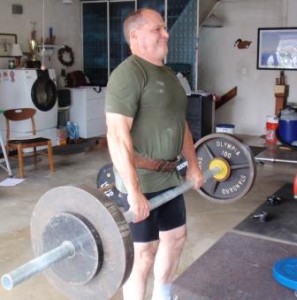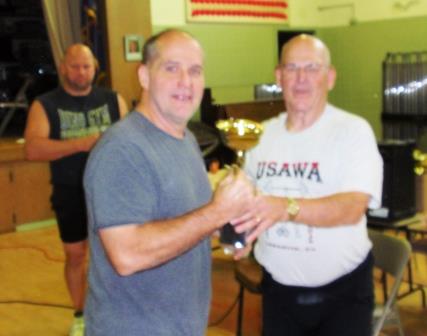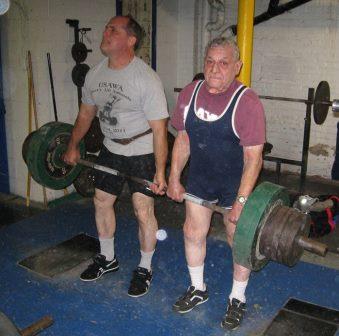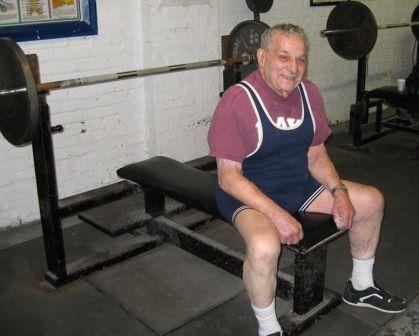By Al Myers
(webmasters note: The following interview with Tom Ryan was done on June 3rd, 2009. I normally don’t rerun USAWA blog stories but with Tom’s recent passing I would like to “air” this one again as a lot of newcomers to the website might not have seen it. Tom was a very unique and eccentric person and his personality comes through in this interview. He was a good friend, and I will miss our weekly email exchanges.)
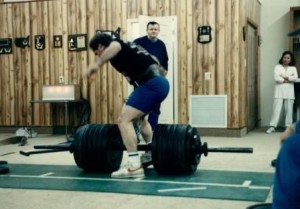
Tom Ryan watching as Barry Bryan does a 1500 pound Hip Lift at a meet in John Vernacchio’s Gym in 1989.
Al: where do you currently live and what do you do for a living?
Tom: I live in Acworth, Georgia (outside Atlanta) and have lived in Georgia most of my life, being a native Atlantan. I was a college professor for decades and now teach online courses for statistics.com. I have also done some course development work for them and do occasional consulting through them. I have written four statistics books (600-page books) for my New York area publisher and expect to finish my fifth book by the end of the year. I have also done a considerable amount of additional writing, including some sports writing, such as six articles on basketball statistics within the past few years for betterbasketball.com. I enjoy doing various types of writing and a few weeks ago wrote a guest column on teaching quantitative courses that was in the Atlanta paper on May 20th. The American Statistical Association, which elected me a Fellow in 2000 (I’ve been a member since 1972), somehow found out about that article and have linked the article at their website.
Al: When did you first start weightlifting and how did you get started?
Tom: I started lifting weights in December, 1958, at the age of 13. I would have made an ideal “before” picture for a bodybuilding course ad as I was 5-7 and weighed only 107 pounds. I was all skin and bones and my father even called me “Bones”. I believe I pressed 40 pounds for 8 reps in my first workout. I was in the 8th grade at the time and there were two kids in my physical education class who couldn’t climb the rope in the gym and touch the ceiling. I was one of the two. Then I started lifting weights and did succeed (to the cheers of my fellow students), even after almost dying from whooping cough and missing a few weeks of school.
I went from “bones” to almost the other extreme, eventually reaching 305 pounds, with my highest competitive bodyweight being 296 at two contests. I did not compete when I was in my prime, as I wanted to wait until I was a national caliber lifter before I entered competition. By my mid-30s, however, I realized that was never going to happen, and that was a depressing realization because I trained very hard. Then my life changed when I wrote to Murray Levin, who ran U.S. Olympic lifting at the time, in 1981 and offered to help in any way that I could. Murray sent my letter to Bill Clark, who immediately wrote to me. Bill had a paragraph about me in his Master’s newsletter in 1982, even though I was only 36 at the time and Master’s lifting then started at age 40. Bill also sent me his Missouri Valley newsletter. This was well before the days of the USAWA but Bill had introduced me to a new world and I now had something to train for.
Al: Was there any one person who introduced you to lifting?
Tom: No one got me started. It was pure self-motivation, being motivated by my lack of strength and muscles. As I aged and started becoming stronger, with a 289 clean and jerk in training at the age of 19, I idolized Tony Garcy, five-time national Olympic lifting champion, and followed his career very closely. I eventually met Tony at the 1966 Senior Nationals and spoke with him briefly then. Several months ago I sent him a sympathy card after the death of one of his sons and received a nice card and note from he and his wife in reply. I was also motivated by Paul Anderson, whom I met in 1972 and corresponded with during the early 1970s, as well as the late 1980s.
Al: When did you first get involved with the all-rounds? Didn’t you compete in one of the very first World Meets?
Tom: I am one of the charter members of the USAWA, as indicated by the list on page 23 of the 5/17/09 edition of the Strength Journal. I competed in my first Zercher Meet in 1987, about the time that plans to start the USAWA were being formalized, so I just naturally became a member of the USAWA. Yes, I competed in the World Meet in Plymouth Meeting, PA in 1989. I suffered a tricep injury during the Pullover and Push event that took a very long time to fully heal.
Al: What have been your favorite lifts?
Tom: Over the years my favorite lifts have been the ones that I can do, quite frankly, and that list shrinks as I age! LOL When I was much younger, I enjoyed pressing and tried different types of pressing. My best pressing performance in USAWA competition occurred at the 1989 Zercher Meet when I did a heels together military press with 200 and then pressed 210 on my last attempt but lost my balance and had to take two steps backward. Later that year I thought I had pressed 209 at the World Meet, but I expected the weight to be heavier than it was and put a bit too much body into the lift, resulting in two red lights for backbend.
Probably my lifetime best pressing, considering form, was done in training one day in 1977 when I did a wide-grip military press with 229 for 4 reps. My heels weren’t together but those were strict presses with no lower body movement at all. That was one of those magic moments when I was really “on” and knew that would never happen again. And it didn’t!
During the late 1980s and early 1990s I made some reasonable one-hand deadlifts in USAWA contests, ranging from 330 to my PR of 345. My back started “complaining” about any type of deadlift with very much weight as I moved through my 50s, so I became somewhat of a one-arm thumbless deadlift specialist, doing over 200 officially. This is the type of lift that allows grip specialists like Ben Edwards to excel. In my case, I think it is a matter of technique because my hand strength is rather ordinary. I also found that I was reasonably good at the rectangular fix, at least for my age, as I made 95 pounds at the age of 61.
Al: I know one of your interests has been the history of weightlifting. Who are some of your favorite old time strongmen?
Tom: There are people who know more about the history of weightlifting and oldetime strongmen than I do, but yes, I have been interested in these subjects for decades and began work on a book on historical strength figures in the late 1980s. I mentioned Tony Garcy previously but I would rather not think of him as “oldetime” since he is only 6 years older than me. LOL. Rather, if we think of strongmen who performed in the general vicinity of 1900, there were certain performances that I wish I could have seen. In particular, one evening in 1889 Apollon (Louis Uni) did not know that the iron bars on a gate that was part of his stage performance had been tempered by a blacksmith, who was bribed by a prankster. Unaware of this, Apollon and his massive forearms struggled to bend the bars, while his wife prodded him , assuming that he was just being lazy. Finally Apollon was able to bend the bars enough for him to slide through them, but he was totally exhausted and explained to the audience that he was unable to continue his performance. David Willoughby believed that this may have been Apollon’s greatest strength feat.
I wish I could have also seen the bent presses of Arthur Saxon. It is hard for me to believe that a man weighing only about 204 pounds could bent press close to 400. (He is credited with 370 but reportedly did 386 unofficially and supposedly attempted 409 but the weights started falling off the bar.) Bent pressing was popular in the 1940s, especially in the New York area, and although Al Beinert bent pressed 360 in the mid-1900s weighing almost 60 pounds more than Saxon, nobody has approached Saxon’s record.
It would also have been fun to meet some of the leading strongmen of centuries ago, like Thomas Topham and Giovanni Belzoni, not to mention the enigmatic giant, Angus McAskill.
Al: Do you have any special memories of any all-round weightlifting meets?
Tom: Well, I would like to forget the injuries that I sustained! LOL Yes, I certainly have fond memories of people with varied backgrounds and professions and from different parts of the country and world getting together for fun and competition. There were personal duels I had with Bill Clark at Zercher Meets, with him insisting that we compete straight up, despite our differences in age and bodyweight. It was fun seeing Steve Schmidt do harness lifts with well over 3,000 pounds, far in excess of what the rest of us did, and more recently to see his feats, either in person or on film, with bar bending and teeth lifting and pulling very heavy vehicles, as well as record-breaking repetition back lifting. Although I didn’t witness it, Joe Garcia’s hand and thigh lift with 1,910 is a tremendous accomplishment, the highest lift on record. Since I go back a long way, there were some competitions in which I saw Ed Zercher do some exhibition leg pressing when he was 80 or so. Yes, I have many fond memories.
Al: What do you think the future of the USAWA will be?
Tom: Over the years, Bill Clark had hoped that the USAWA could attract some of the strength stars of the past, but that hasn’t happened. Jim Bradford, who is now 80 and was a silver medalist in the 1952 and 1960 Olympics, has been an ardent follower, but I don’t recall him competing in any USAWA contest. There are so many official lifts that virtually everyone, regardless of physical condition, will be able to find some lifts that they can do. I would like to see more people compete, both young and old, but our numbers are dwindling, not increasing. Hopefully your considerable and praiseworthy efforts with this website, Al, will increase interest in the USAWA. We can only hope.
Al: Thank you, Tom, for participating in this interview.

